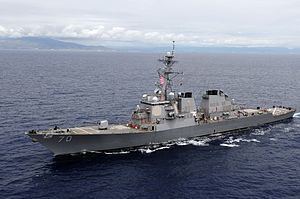Name USS Hopper Ordered 8 April 1992 Commissioned 6 September 1997 Construction started 23 February 1995 Draft 9.45 m | Laid down 23 February 1995 Length 154 m Launched 6 January 1996 Builder Bath Iron Works | |
Homeport Pearl Harbor, Hawaii, U.S. | ||
Uss hopper commissioning 1997 part 1
USS Hopper (DDG-70) is an Arleigh Burke-class guided missile destroyer of the United States Navy, named for the pioneering computer scientist Rear Admiral "Amazing" Grace Hopper.
Contents
- Uss hopper commissioning 1997 part 1
- Uss hopper leaves pearl harbor hd
- Deployments
- Commanding officers
- Shield
- Crest
- Motto
- Seal
- References

Hopper is only the second U.S. Navy warship to be named for a woman from the Navy's own ranks. This ship is the 20th destroyer of her class. USS Hopper (DDG-70) was the 11th ship of this class to be built at Bath Iron Works in Bath, Maine, and construction began on 23 February 1995. She was launched and christened on 6 January 1996. On 6 September 1997, she was commissioned in San Francisco outside of Silicon Valley with Commander Thomas D. Crowley in command.

Uss hopper leaves pearl harbor hd
Deployments

Hopper has participated in multiple deployments to East Asia and the Persian Gulf, including RIMPAC 98, three individual PACMEF deployments, an Expeditionary Strike Group deployment to the Persian Gulf in 2004, and a deployment to Southeast Asia in support of Cooperation Afloat Readiness and Training (CARAT) 2006. In addition, Hopper has been foremost in the field of Ballistic Missile Defense.
On 1 April 2002, Hopper departed for a six-month deployment to the North Persian Gulf.

On 12 November 2007, Hopper departed with the Tarawa Expeditionary Strike Group for a scheduled deployment to the Fifth Fleet and Seventh Fleet.

On 6 January 2008, Hopper was involved in an incident with five Iranian Revolutionary Guard gunboats. Hopper, the cruiser Port Royal and the frigate Ingraham were entering the Persian Gulf through the Strait of Hormuz when five Iranian boats approached them at high speed and in a threatening manner. The U.S. ships had been in the Arabian Sea searching for a sailor who had been missing from the Hopper for one day. The U.S. Navy said the Iranian boats made "threatening" moves toward the U.S. vessels, coming as close as 200 yards (180 m). The U.S. Navy received a radio transmission saying, "I am coming to you. You will explode after a few minutes." As the U.S. ships prepared to fire, the Iranians abruptly turned away, the U.S. officials said. Before leaving, the Iranians dropped white boxes into the water in front of the U.S. ships. The U.S. ships did not investigate the boxes.
Officials from the two nations differed on the severity of the incident. The Iranians claimed they were conducting normal maneuvers while American officials claimed that an imminent danger to American naval vessels existed.
On 15 April 2011, Hopper departed from Pearl Harbor on a deployment to Asia and the Middle East.
On 22 June 2014, Hopper, with its Aegis Weapon System, detected and tracked a test missile launched from the Reagan Test Site on Kwajalein Atoll using its onboard AN/SPY-1 radar, providing critical targeting data to a long-range ground-based interceptor (GBI) launched from Vandenberg Air Force Base, California. GBI's protect the US from limited long-range ballistic missile attack.
Commanding officers
The Commanding Officer (CO) of USS Hopper (DDG-70) is the most senior officer that is in command of the ship. Sailors will refer to the CO as "the Captain" (regardless of rank), or sometimes informally as "Skipper". Below is the list of commanding officers of USS Hopper.
Shield
The shield has a background of blue. In the center is a gold lion with red talons.
The traditional Navy colors were chosen for the shield because dark blue and gold represents devotion to duty and excellence respectively. The Lion is a symbol for strength and courage. It stands for USS Hopper’s survivability characteristics while referring to the ships motto of “DARE AND DO”. The rampant lion was adapted from the arms of Scotland denoting Rear Admiral Hopper’s culture.
Crest
The crest consists of a lozenge with a silver star above the trident. Surrounding the lozenge is a wreath with lightning bolts stemming from the bottom. The crest is completed by the blue and gold framing.
Traditionally used in the coat of arms of women, the lozenge, honors Rear Admiral Grace Hopper. The single silver star is a representative to Admiral Hopper for being the first woman to achieve the rank of rear admiral. The trident symbolizes the focus of her life’s work and love for the United States Navy and her Naval service. Lightning bolts along with the framing on the bottom of the shield suggest the appearance of the ship’s hull cutting through water, also representing the sophistication and power of the AEGIS warship. The wreath, consisting of laurel and oak represent honor and strength. The color gold represents excellence, while red denotes courage and sacrifice.
Motto
The motto is written on a scroll of white with red trim.
The ships motto “AUDE ET EFFICE” can be translated to “DARE AND DO” within context of a command. RADM Hopper used this often when issuing advice. The phrase captures RADM Hopper’s pursuit to push the limits of conventional thinking, looking beyond the norm, for innovative solutions and approaches to problem solving. The phrase demonstrates RADM Hopper’s spirit, paying tribute to her academic merit.
Seal
The coat of arms in full color as in the blazon, upon a white background enclosed within a dark blue oval border edged on the outside with a gold rope and bearing the inscription "USS HOPPER" at the top and "DDG 70" in the base all gold.
